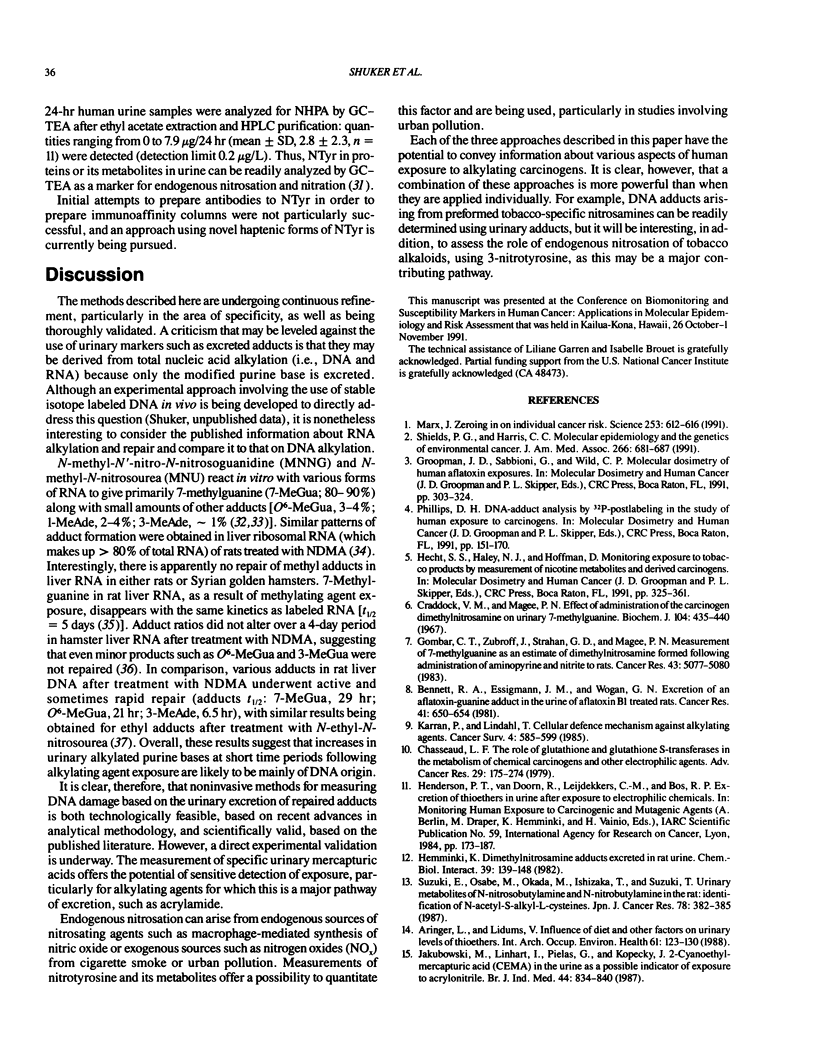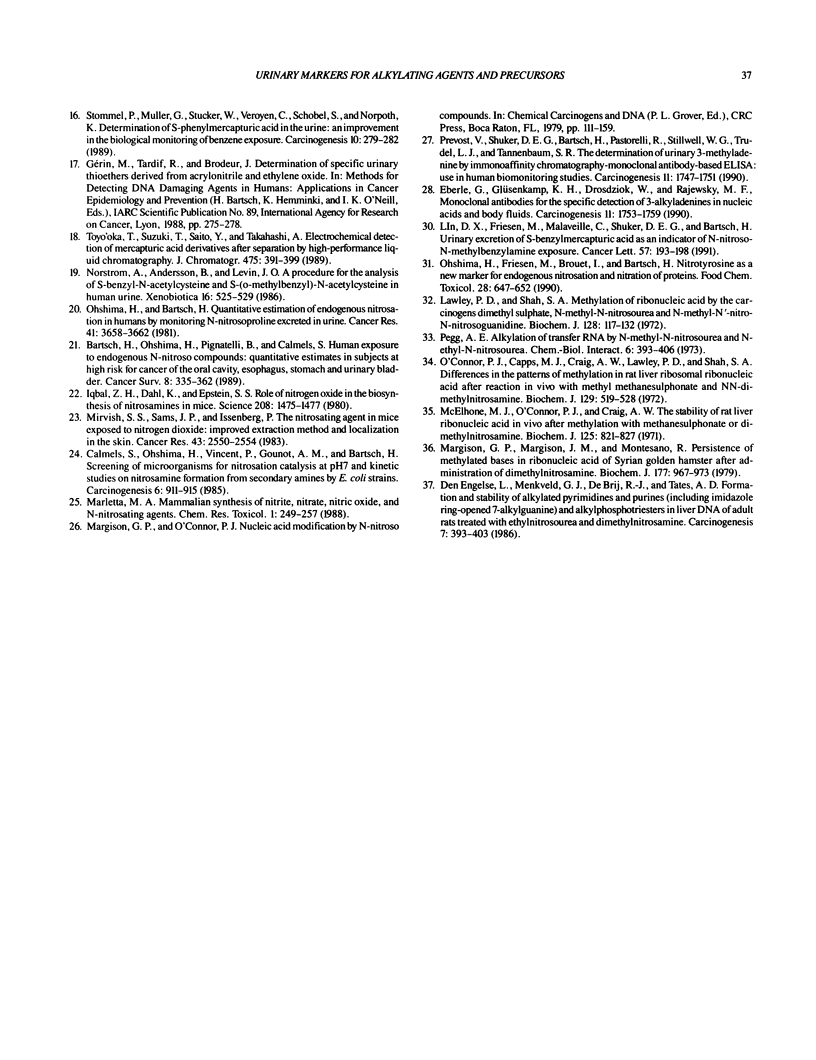Abstract
Noninvasive methodologies for measuring carcinogen exposure in humans, based on the use of urinary markers, are being developed and validated for use in molecular epidemiological studies. A range of 3-alkyladenines can be determined in urine samples by an immunoaffinity purification-GC/MS approach [3-methyladenine, 3-ethyladenine, 3-(2-hydroxyethyl)adenine, and 3-benzyladenine]. Using this method, recent results in human subjects suggest that urinary 3-alkyladenines are potentially useful markers of alkylating agent exposure, particularly where the backgrounds of such adducts are much lower than 3-methyladenine. Urinary excretion of S-benzylmercapturic acid has been studied in experimental animals as a marker of exposure to benzylating agents such as N-nitroso-methylbenzylamine. 3-Nitrotyrosine (NTyr) is formed in vivo in tissue or blood proteins after exposure to nitrosating and/or nitrating agents such as tetranitromethane. After turnover of proteins, NTyr is released and excreted in urine as metabolites 3-nitro-4-hydroxy-phenylacetic acid and 3-nitro-4-hydroxyphenylacetic acid, which are determined by GC with a thermal energy analyzer. The sensitivity and specificity, combined with ease of use, of these noninvasive biomonitoring approaches means that they may be readily incorporated into molecular epidemiological studies in which exposure to nitrosating and alkylating agents may be important risk factors.
Full text
PDF




Selected References
These references are in PubMed. This may not be the complete list of references from this article.
- Aringer L., Lidums V. Influence of diet and other factors on urinary levels of thioethers. Int Arch Occup Environ Health. 1988;61(1-2):123–130. doi: 10.1007/BF00381616. [DOI] [PubMed] [Google Scholar]
- Bartsch H., Ohshima H., Pignatelli B., Calmels S. Human exposure to endogenous N-nitroso compounds: quantitative estimates in subjects at high risk for cancer of the oral cavity, oesophagus, stomach and urinary bladder. Cancer Surv. 1989;8(2):335–362. [PubMed] [Google Scholar]
- Bennett R. A., Essigmann J. M., Wogan G. N. Excretion of an aflatoxin-guanine adduct in the urine of aflatoxin B1-treated rats. Cancer Res. 1981 Feb;41(2):650–654. [PubMed] [Google Scholar]
- Calmels S., Ohshima H., Vincent P., Gounot A. M., Bartsch H. Screening of microorganisms for nitrosation catalysis at pH 7 and kinetic studies on nitrosamine formation from secondary amines by E. coli strains. Carcinogenesis. 1985 Jun;6(6):911–915. doi: 10.1093/carcin/6.6.911. [DOI] [PubMed] [Google Scholar]
- Chasseaud L. F. The role of glutathione and glutathione S-transferases in the metabolism of chemical carcinogens and other electrophilic agents. Adv Cancer Res. 1979;29:175–274. doi: 10.1016/s0065-230x(08)60848-9. [DOI] [PubMed] [Google Scholar]
- Craddock V. M., Magee P. N. Effect of administration of the carcinogen dimethylnitrosamine on urinary 7-methylguanine. Biochem J. 1967 Aug;104(2):435–440. doi: 10.1042/bj1040435. [DOI] [PMC free article] [PubMed] [Google Scholar]
- Den Engelse L., Menkveld G. J., De Brij R. J., Tates A. D. Formation and stability of alkylated pyrimidines and purines (including imidazole ring-opened 7-alkylguanine) and alkylphosphotriesters in liver DNA of adult rats treated with ethylnitrosourea or dimethylnitrosamine. Carcinogenesis. 1986 Mar;7(3):393–403. doi: 10.1093/carcin/7.3.393. [DOI] [PubMed] [Google Scholar]
- Eberle G., Glüsenkamp K. H., Drosdziok W., Rajewsky M. F. Monoclonal antibodies for the specific detection of 3-alkyladenines in nucleic acids and body fluids. Carcinogenesis. 1990 Oct;11(10):1753–1759. doi: 10.1093/carcin/11.10.1753. [DOI] [PubMed] [Google Scholar]
- Gombar C. T., Zubroff J., Strahan G. D., Magee P. N. Measurement of 7-methylguanine as an estimate of the amount of dimethylnitrosamine formed following administration of aminopyrine and nitrite to rats. Cancer Res. 1983 Nov;43(11):5077–5080. [PubMed] [Google Scholar]
- Hemminki K. Dimethylnitrosamine adducts excreted in rat urine. Chem Biol Interact. 1982 Mar 15;39(2):139–148. doi: 10.1016/0009-2797(82)90117-x. [DOI] [PubMed] [Google Scholar]
- Iqbal Z. M., Dahl K., Epstein S. S. Role of nitrogen dioxide in the biosynthesis of nitraosamines in mice. Science. 1980 Mar 28;207(4438):1475–1477. doi: 10.1126/science.7361099. [DOI] [PubMed] [Google Scholar]
- Jakubowski M., Linhart I., Pielas G., Kopecký J. 2-Cyanoethylmercapturic acid (CEMA) in the urine as a possible indicator of exposure to acrylonitrile. Br J Ind Med. 1987 Dec;44(12):834–840. doi: 10.1136/oem.44.12.834. [DOI] [PMC free article] [PubMed] [Google Scholar]
- Karran P., Lindahl T. Cellular defence mechanisms against alkylating agents. Cancer Surv. 1985;4(3):583–599. [PubMed] [Google Scholar]
- Lawley P. D., Shah S. A. Methylation of ribonucleic acid by the carcinogens dimethyl sulphate, N-methyl-N-nitrosourea and N-methyl-N'-nitro-N-nitrosoguanidine. Comparisons of chemical analyses at the nucleoside and base levels. Biochem J. 1972 Jun;128(1):117–132. doi: 10.1042/bj1280117. [DOI] [PMC free article] [PubMed] [Google Scholar]
- Lin D. X., Friesen M., Malaveille C., Shuker D. E., Bartsch H. Urinary excretion of S-benzylmercapturic acid as an indicator of N-nitroso-N-methylbenzylamine exposure. Cancer Lett. 1991 May 24;57(3):193–198. doi: 10.1016/0304-3835(91)90156-c. [DOI] [PubMed] [Google Scholar]
- Margison G. P., Margison J. M., Montesano R. Persistence of methylated bases in ribonucleic acid of syrian golden hamster liver after administration of dimethylnitrosamine. Biochem J. 1979 Mar 1;177(3):967–973. doi: 10.1042/bj1770967. [DOI] [PMC free article] [PubMed] [Google Scholar]
- Marletta M. A. Mammalian synthesis of nitrite, nitrate, nitric oxide, and N-nitrosating agents. Chem Res Toxicol. 1988 Sep-Oct;1(5):249–257. doi: 10.1021/tx00005a001. [DOI] [PubMed] [Google Scholar]
- Marx J. Zeroing in on individual cancer risk. Science. 1991 Aug 9;253(5020):612–616. doi: 10.1126/science.1651561. [DOI] [PubMed] [Google Scholar]
- McElhone M. J., O'Connor P. J., Craig A. W. The stability of rat liver ribonucleic acid in vivo after methylation with methyl methanesulphonate or dimethylnitrosamine. Biochem J. 1971 Dec;125(3):821–827. doi: 10.1042/bj1250821. [DOI] [PMC free article] [PubMed] [Google Scholar]
- Mirvish S. S., Sams J. P., Issenberg P. The nitrosating agent in mice exposed to nitrogen dioxide: improved extraction method and localization in the skin. Cancer Res. 1983 Jun;43(6):2550–2554. [PubMed] [Google Scholar]
- Norström A., Andersson B., Levin J. O. A procedure for the analysis of S-benzyl-N-acetylcysteine and S-(o-methylbenzyl)-N-acetylcysteine in human urine. Xenobiotica. 1986 Jun;16(6):525–529. doi: 10.3109/00498258609043541. [DOI] [PubMed] [Google Scholar]
- O'Connor P. J., Capps M. J., Craig A. W., Lawley P. D., Shah S. A. Differences in the patterns of methylation in rat liver ribosomal ribonucleic acid after reaction in vivo with methyl methanesulphonate and NN-dimethylnitrosamine. Biochem J. 1972 Sep;129(3):519–528. doi: 10.1042/bj1290519. [DOI] [PMC free article] [PubMed] [Google Scholar]
- Ohshima H., Bartsch H. Quantitative estimation of endogenous nitrosation in humans by monitoring N-nitrosoproline excreted in the urine. Cancer Res. 1981 Sep;41(9 Pt 1):3658–3662. [PubMed] [Google Scholar]
- Ohshima H., Friesen M., Brouet I., Bartsch H. Nitrotyrosine as a new marker for endogenous nitrosation and nitration of proteins. Food Chem Toxicol. 1990 Sep;28(9):647–652. doi: 10.1016/0278-6915(90)90173-k. [DOI] [PubMed] [Google Scholar]
- Pegg A. E. Alkylation of transfer RNA by N-methyl-N-nitrosourea and N-ethyl-N-nitrosourea. Chem Biol Interact. 1973 Jun;6(6):393–406. doi: 10.1016/0009-2797(73)90059-8. [DOI] [PubMed] [Google Scholar]
- Prevost V., Shuker D. E., Bartsch H., Pastorelli R., Stillwell W. G., Trudel L. J., Tannenbaum S. R. The determination of urinary 3-methyladenine by immunoaffinity chromatography-monoclonal antibody-based ELISA: use in human biomonitoring studies. Carcinogenesis. 1990 Oct;11(10):1747–1751. doi: 10.1093/carcin/11.10.1747. [DOI] [PubMed] [Google Scholar]
- Shields P. G., Harris C. C. Molecular epidemiology and the genetics of environmental cancer. JAMA. 1991 Aug 7;266(5):681–687. [PubMed] [Google Scholar]
- Stommel P., Müller G., Stücker W., Verkoyen C., Schöbel S., Norpoth K. Determination of S-phenylmercapturic acid in the urine--an improvement in the biological monitoring of benzene exposure. Carcinogenesis. 1989 Feb;10(2):279–282. doi: 10.1093/carcin/10.2.279. [DOI] [PubMed] [Google Scholar]


